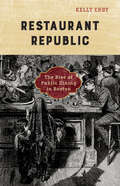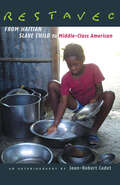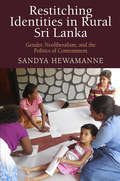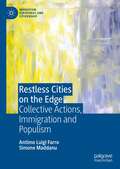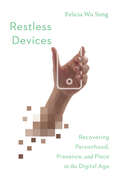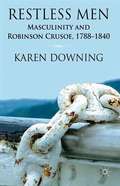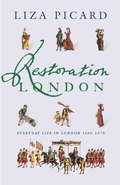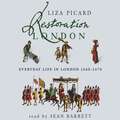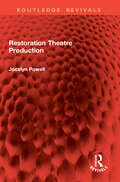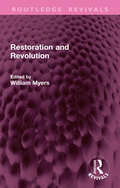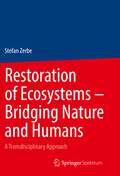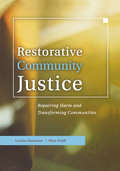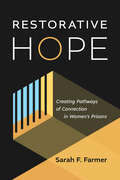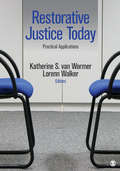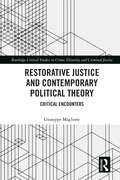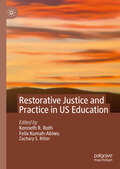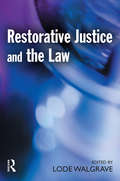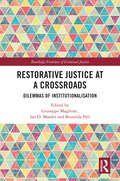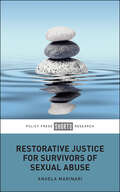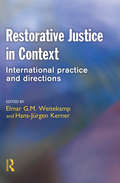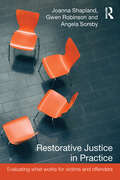- Table View
- List View
Restaurant Republic: The Rise of Public Dining in Boston (A Quadrant Book)
by Kelly ErbyBefore the 1820s, the vast majority of Americans ate only at home. As the nation began to urbanize and industrialize, home and work became increasingly divided, resulting in new forms of commercial dining. In this fascinating book, Kelly Erby explores the evolution of such eating alternatives in Boston during the nineteenth century. Why Boston? Its more modest assortment of restaurants, its less impressive—but still significant—expansion in commerce and population, and its growing diversity made it more typical of the nation&’s other urban centers than New York. Restaurants, clearly segmented along class, gender, race, ethnic, and other lines, helped Bostonians become more comfortable with deepening social stratification in their city and young republic even as the experience of eating out contributed to an emerging public consumer culture. Restaurant Republic sheds light on how commercial dining both reflected and helped shape growing fragmentation along lines of race, class, and gender—from the elite Tremont House, which served fashionable French cuisine, to such plebeian and ethnic venues as oyster saloons and Chinese chop suey houses. The epilogue takes us to the opening, in 1929 near Boston, of the nation&’s first Howard Johnson&’s and that restaurant&’s establishment as a franchise in the next decade. The result is a compelling story that continues to shape America.
Restavec: From Haitian Slave Child to Middle-Class American
by Jean-Robert CadetAfrican slaves in Haiti emancipated themselves from French rule in 1804 and created the independent black republic in the Western Hemisphere. But they reinstituted slavery for the most vulnerable members of Haitian society -- the children of the poor -- by using them as unpaid servants to the wealthy. These children were -- and still are -- restavecs, a French term whose literal meaning of "staying with" disguises the unremitting labor, abuse, and denial of education that characterizes the children's lives. In this memoir, Jean-Robert Cadet recounts the harrowing story of his youth as a restavec, as well as his inspiring climb to middle-class American life. He vividly describes what it was like to be an unwanted illegitimate child "staying with" a well-to-do family whose physical and emotional abuse was sanctioned by Haitian society. He also details his subsequent life in the United States, where, despite American racism, he put himself through college and found success in the Army, in business, and finally in teaching.
Restavec: From Haitian Slave Child to Middle-Class American
by Jean-Robert CadetThis inspiring memoir recounts a man’s harrowing journey from unpaid child labor in Haiti to a successful life in the United States.African slaves in Haiti emancipated themselves from French rule in 1804 and created the first independent black republic in the Western Hemisphere. But they reinstituted slavery for the most vulnerable members of Haitian society—the children of the poor—by using them as unpaid servants to the wealthy. These children were—and still are—restavecs, a French term whose literal meaning of "staying with" disguises the unremitting labor, abuse, and denial of education that characterizes the children's lives.In this memoir, Jean-Robert Cadet recounts the harrowing story of his youth as a restavec, as well as his inspiring climb to middle-class American life. He vividly describes what it was like to be an unwanted illegitimate child "staying with" a well-to-do family whose physical and emotional abuse was sanctioned by Haitian society. He also details his subsequent life in the United States, where, despite American racism, he put himself through college and found success in the Army, in business, and finally in teaching.
Restitching Identities in Rural Sri Lanka: Gender, Neoliberalism, and the Politics of Contentment (Contemporary Ethnography)
by Sandya HewamanneSandya Hewamanne's Stitching Identities in a Free Trade Zone analyzed how female factory workers in Sri Lanka's free trade zones challenged conventional notions about marginalized women at the bottom of the global economy. In Restitching Identities in Rural Sri Lanka Hewamanne now follows many of these same women to explore the ways in which they negotiate their social and economic lives once back in their home villages. Drawing on ethnographic fieldwork conducted over fifteen years, the book explores how the former free-trade-zone workers manipulate varied forms of capital—social, cultural, and monetary— to become local entrepreneurs and community leaders, while simultaneously initiating gradual changes in rural social hierarchies and gender norms.Free trade zones introduce Sri Lankan women to neoliberal ways of fashioning selves, Hewamanne contends. Her book illustrates how varied manifestations of neoliberal attitudes within local contexts result in new articulations of what it is to be an entrepreneur as well as a good woman. By focusing on how former workers decenter neoliberal market relations while using their entrepreneurial and civic activities to reimagine social life in ways more satisfying to them and their loved ones—what the author calls a politics of contentment—the book sheds light on new political possibilities in contexts where both reproduction of neoliberal economic relations and implementation of alternatives co-exist.
Restless Cities on the Edge: Collective Actions, Immigration and Populism (Migration, Diasporas and Citizenship)
by Antimo Luigi Farro Simone MaddanuThis book is a sociological description and analysis of urban collective actions, protests, resistance, and riots that started in the 1990s and continue in different forms to this date in Rome, Italy. Through participant observation, ethnographic study, and in-depth qualitative interviews—often occurring during times of protest or even violent action—this book studies a variety of urban realities: grassroots movements, anti-migrant district riots, and the daily lives of the fluid and fluctuating multi-ethnic groups in the city. Ultimately, this book gives voice to some of the protagonists involved, proposing interpretations to each reality described, but also making cross-connections with politics and migration when pertinent. It offers a new understanding of urban collective actions cognizant of the 'common goods', but also of the emergence of new right-wing populism.
Restless Devices: Recovering Personhood, Presence, and Place in the Digital Age
by Felicia Wu SongWhat kind of people are we becoming with personal technologies in hand?And who do we really want to be?
Restless Men: Masculinity and Robinson Crusoe, 1788–1840
by Karen DowningRobinson Crusoe's call to adventure and do-it-yourself settlement resonated with British explorers. In tracing the links in a discursive chain through which a particular male subjectivity was forged, Karen Downing reveals how such men took their tensions with them to Australia, so that the colonies never were a solution to restless men's anxieties.
Restoration London: Everyday Life In The 1660s
by Liza Picard'A joy of a book ... It radiates throughout that quality so essential in a good historian: infinite curiosity' ObserverHow did you clean your teeth in the 1660s? What make-up did you wear? What pets did you keep?Making use of every possible contemporary source, Liza Picard presents an engrossing picture of how life in London was really lived in an age of Samuel Pepys, the libertine court of Charles II and the Great Fire of London. The topics covered include houses and streets, gardens and parks, cooking, clothes and jewellery, cosmetics, hairdressing, housework, laundry and shopping, medicine and dentistry, sex education, hobbies, etiquette, law and crime, religion and popular belief. The London of 350 years ago is brought (and sometimes horrifyingly) to life.
Restoration London: Everyday Life in the 1660s (Life of London #2)
by Liza PicardHow did you clean your teeth in the 1660s? What make-up did you wear? What pets did you keep?Making use of every possible contemporary source, Liza Picard presents an engrossing picture of how life in London was really lived in an age of Samuel Pepys, the libertine court of Charles II and the Great Fire of London. The topics covered include houses and streets, gardens and parks, cooking, clothes and jewellery, cosmetics, hairdressing, housework, laundry and shopping, medicine and dentistry, sex education, hobbies, etiquette, law and crime, religion and popular belief. The London of 350 years ago is brought (and sometimes horrifyingly) to life.'A joy of a book ... It radiates throughout that quality so essential in a good historian: infinite curiosity' Observer
Restoration London: Everyday Life in the 1660s (Life of London #2)
by Liza PicardMaking use of every possible contemporary source - diaries, memoirs, advice books, government papers, almanacs, even the Register of Patents - Liza Picard presents an enthralling picture of how life in London was really lived in the 1600s: the houses and streets, gardens and parks, cooking, clothes and jewellery, cosmetics, hairdressing, housework, laundry and shopping, medicine and dentistry, sex, education, hobbies, etiquette, law and crime, religion and popular beliefs.Read by Sean Barrett(p) 2004 Orion Publishing Group
Restoration London: From Poverty to Pets, From Medicine to Magic, From Slang to Sex, From Wallpaper to Women's Rights
by Liza PicardThis is a social history of the period 1660-70 with frequent references to Pepys Diary and other firsthand documents. Easy to read style and the perspective of a non-professional historian are interesting. The book gives a flavor of the period rather than giving all the events which occurred during it.
Restoration Theatre Production (Routledge Revivals)
by Jocelyn PowellOriginally published in 1984, this book recreates the unique atmosphere of the Restoration playhouses in order to demonstrate how theatrical conditions spurred authors into creating new forms of tragedy, comedy and opera, the techniques of which anticipated the ideas of ‘gestus’ and ‘alienation’ first articulated by Bertold Brecht in the 20th century. The book explores the ways in which the theories of the time affected the practice, showing the crucial importance of Dryden’s work in the playhouse and of the collaboration of authors and theatre companies. It examines particular texts, to highlight the themes and present the spectrum of dramatic experience in action. The book, which is extensively illustrated, also shows how the Restoration style, although developed by particular actors and dramatists, declined under the commercial pressures of the end of the century.
Restoration and History: The Search for a Usable Environmental Past (Routledge Studies in Modern History)
by Marcus HallOnce a forest has been destroyed, should one plant a new forest to emulate the old, or else plant designer forests to satisfy our immediate needs? Should we aim to re-create forests, or simply create them? How does the past shed light on our environmental efforts, and how does the present influence our environmental goals? Can we predict the future of restoration? This book explores how a consideration of time and history can improve the practice of restoration. There is a past of restoration, as well as past assumptions about restoration, and such assumptions have political and social implications. Governments around the world are willing to spend billions on restoration projects – in the Everglades, along the Rhine River, in the South China Sea – without acknowledging that former generations have already wrestled with repairing damaged ecosystems, that there have been many kinds of former ecosystems, and that there are many former ways of understanding such systems. This book aims to put the dimension of time back into our understanding of environmental efforts. Historic ecosystems can serve as models for our restorative efforts, if we can just describe such ecosystems. What conditions should be brought back, and do such conditions represent new natures or better pasts? A collective answer is given in these pages – and it is not a unified answer.
Restoration and Revolution (Routledge Revivals)
by William MyersThe year 1688 is a turning point in English culture, and one from which can be dated numerous distinctively ‘modern’ notions of truth, property and political order. The texts assembled in this collection, originally published in 1986, focus on this intellectual adjustment from five related perspectives: from the traditions of social thought, philosophical thought, Anglicanism and royalism, latitudinarianism and the whig tradition, and the dissenting/radical/quietist milieu. The texts highlight not only the views that prevailed (Halifax and Locke), but those that failed (Dryden and Temple) and those that were reduced to marginality (Baxter). The substantial introduction by the editor brings out key themes such as the shifting notion of property and the related themes of inheritance, education and marriage, as well as the uneasy intellectual alliances of the period.
Restoration of Ecosystems – Bridging Nature and Humans: A Transdisciplinary Approach
by Stefan ZerbeIn this interdisciplinary specialist book, which bridges the gap between the natural and social sciences, both the scientific principles of restoration ecology and practical aspects of ecosystem restoration are comprehensively presented. The diversity of land use types with a focus on Central Europe is highlighted and case studies of practical restoration projects are presented. The textbook offers both students who deal with the environment, scientists and practitioners a profound and up-to-date, but also critical overview of the state of knowledge. This book opens up the broad spectrum of degraded ecosystems of Central European natural and cultural landscapes. In further chapters, marine ecosystems and their restoration as well as development potentials as well as the limits of restoration are discussed in more detail. The ecological fundamentals are expanded through an interdisciplinary perspective taking into account environmental ethics, sociology, anthropology and economics. In addition to an up-to-date overview of the various areas and fields of activity in restoration ecology and ecosystem restoration, the textbook provides a valuable basis for studies, science and practice. The students also receive assistance in searching for literature and critical fact analysis, and the lecturers on teaching forms and interdisciplinary approaches to discussion in restoration ecology. The ecological fundamentals are expanded through an interdisciplinary perspective taking into account environmental ethics, sociology, anthropology and economics. In addition to an up-to-date overview of the various areas and fields of activity in restoration ecology and ecosystem restoration, the textbook provides a valuable basis for studies, science and practice. The students also receive assistance in searching for literature and critical fact analysis, and the lecturers on teaching forms and interdisciplinary approaches to discussion in restoration ecology. The ecological fundamentals are expanded through an interdisciplinary perspective taking into account environmental ethics, sociology, anthropology and economics. In addition to an up-to-date overview of the various areas and fields of activity in restoration ecology and ecosystem restoration, the textbook provides a valuable basis for studies, science and practice. The students also receive assistance in searching for literature and critical fact analysis, and the lecturers on teaching forms and interdisciplinary approaches to discussion in restoration ecology. In addition to an up-to-date overview of the various areas and fields of activity in restoration ecology and ecosystem restoration, the textbook provides a valuable basis for studies, science and practice. The students also receive assistance in searching for literature and critical fact analysis, and the lecturers on teaching forms and interdisciplinary approaches to discussion in restoration ecology. In addition to an up-to-date overview of the various areas and fields of activity in restoration ecology and ecosystem restoration, the textbook provides a valuable basis for studies, science and practice. The students also receive assistance in searching for literature and critical fact analysis, and the lecturers on teaching forms and interdisciplinary approaches to discussion in restoration ecology.This book is a translation of the original German 1st edition Renaturierung von Ökosystemen im Spannungsfeld von Mensch und Umwelt by Stefan Zerbe, , published by Springer Fachmedien Wiesbaden GmbH, part of Springer Nature in 2019. The translation was done with the help of artificial intelligence (machine translation by the service DeepL.com). A subsequent human revision was done primarily in terms of content, so that the book will read stylistically differently from a conventional translation. Springer Nature works continuously to further the development of tools for the production of books and on the related technologies to support the authors.
Restorative Community Justice: Repairing Harm and Transforming Communities
by Gordon Bazemore Mara SchiffAn anthology of original essays, this book presents debates over practice, theory, and implementation of restorative justice. Attention is focused on the movement’s direction toward a more holistic, community-oriented approach to criminal justice intervention.
Restorative Hope: Creating Pathways of Connection in Women's Prisons
by Sarah F. FarmerHow theological education can engender life-giving hope for incarcerated women Amid dehumanizing conditions, incarcerated people strive to generate hope. As one returning citizen explains, &“Hope is not just sitting around waiting for things to change. Hope is not always an individual making things change. Hope is sometimes a community making things change.&” What can theologians, teachers, and chaplains do to assist their work? Sarah F. Farmer amplifies the voices of women who are or have been incarcerated to learn what supports their flourishing. Combining theology and sociology, Farmer shows how theological education can help cultivate the resilience and connection that women describe as life-giving in and after prison. Based in her own ministry, this pedagogy incorporates artistic expression and critical thinking about justice to cultivate agency. Restorative Hope will open readers&’ eyes to the lived realities of the US penitentiary system. Educators and theologians seeking to serve those in prison will find a wealth of firsthand perspective and practical resources in these pages.
Restorative Justice Today: Practical Applications
by Ms Lorenn Walker Katherine S. Van WormerRestorative Justice Today: Applications of Restorative Interventions takes a hard look at the issues and concepts surrounding restorative justice and current restorative practices used in a broad range of areas today. In a time when the cost of prisons and jails is on the rise resulting in more offenders being kept out of the community, this timely and contemporary book exposes readers to a range of restorative practices that can be implemented. The authors, renowned experts in the area of restorative justice, provide information not found in other restorative justice texts.
Restorative Justice and Contemporary Political Theory: Critical Encounters (Routledge Critical Studies in Crime, Diversity and Criminal Justice)
by Giuseppe MaglioneOutlining an original analysis of the political dimension of restorative justice, this book seeks both to enhance the critical comprehension of this phenomenon and to forge new tools for acting politically through restorative justice, inviting restorative justice scholars, practitioners and advocates to become a radical political movement.Restorative justice is widely studied, nationally and internationally legislated, and increasingly practised; however, the growth of relevant policy, practice and research has been only marginally accompanied by the development of updated, theoretically informed and critical reflections on the relationships between politics and restorative justice. This is a significant problem since neglecting the political dimension may limit the capacity of the restorative justice movement to critically appreciate its possible role in confronting oppressive social and political arrangements. This book addresses this gap by providing reflections on restorative justice in relation to six complex political concepts – difference, sovereignty, community, identity, equality and subalternity. Engaging with the thoughts of Gilles Deleuze, Giorgio Agamben, Jean-Luc Nancy, Judith Butler, Jacques Rancière and Gayatri Chakravorty Spivak, each chapter works as a prism to unravel and reconstruct creatively restorative justice unearthing its political conditions and effects.Providing an innovative contribution to our thinking about the political nature and significance of restorative justice from the specific perspective of political theory, Restorative Justice and Contemporary Political Theory will appeal to both students and scholars of restorative justice specifically and of criminal justice and criminology more broadly.
Restorative Justice and Practice in US Education
by Zachary S. Ritter Kenneth R. Roth Felix Kumah-AbiwuThis edited volume offers a comprehensive overview of the dual concepts of Restorative Justice as a legal remedy and Restorative Practice as a philosophy to reduce harm and build resilient and just communities within social, cultural, and educational institutions. With contributions from leading practitioners and scholars, the book serves as a valuable resource for institutions seeking to center equity and reduce harm in multicultural learning spaces. Chapters combine insights into the origins and intent of Restorative Justice and Practice, showcase some of their early applications in higher education settings and beyond, and highlight their potential for promoting peace and building community on campuses across the country.
Restorative Justice and the Law
by Lode WalgraveRestorative justice has developed rapidly from being a barely known term to occupying a central role in debates on the future of criminal justice. But as it has become part of the mainstream of debate, so new tensions and issues have emerged. One of the most crucial issues is to find an appropriate combination of restorative justice, based essentially on informal deliberation, and the law. The purpose of this book is to analyse the several dimensions to this issue. It explores the social and ethical foundations of restorative justice, seeks to position it in relation to both rehabilitation and punishment, and examines the possibility of developing and incorporating restorative justice as the mainstream response to crime in terms of the principles of constitutional democracy. Amongst the questions it addresses are the following: How are informal processes to be juxtaposed with formal procedures? What is the appropriate relationship between voluntarism and coercion? How can the procedures and practices of restorative justice be combined with legal standards, safeguards and precepts? How can one balance restorative responses with legally sanctioned punishment? In this book a distinguished team of contributors consider this crucial set of relationships between restorative justice and the law, building upon papers and discussions at the fifth international restorative justice conference in Leuven, Belgium, in September 2001. restorative justice has grown rapidly throughout the worldthis book addresses the central issue of relationship of restorative justice to existing law and legal systemschapters from world leading authorities
Restorative Justice at a Crossroads: Dilemmas of Institutionalisation (Routledge Frontiers of Criminal Justice)
by Giuseppe Maglione, Ian D. Marder and Brunilda PaliThis book reflects on the institutionalisation of restorative justice over the last 20 years and offers a critical analysis of the qualitative consequences generated by such a process on the normative structure of restorative justice, and on its understanding and uses in practice. Bringing together an international collection of leading scholars, this book provides a range of context-sensitive case studies that enhance our understanding of the development of international, national and institutional policy frameworks for restorative justice, the mainstreaming of practices within the criminal justice system, the proliferation of cultural, social and political co-optations of restorative justice and the ways in which the formalisation of the restorative justice movement have affected its values, aims and goals.
Restorative Justice for Survivors of Sexual Abuse
by Angela MarinariIntegral to sexual abuse survivors’ healing is understanding the nature of their abuse. Drawing on interviews, this book gives a voice to survivors and illuminates how restorative justice processes can meet their justice needs. With a unique focus on the people around the survivor rather than on the abuser, it addresses the harm caused to survivors by those who enable their abuse, who fail to protect them, or fail to believe them. Marinari offers radical solutions for the development of restorative justice programs and policy initiatives, including practical guidelines for practitioners, and new directions for academic research.
Restorative Justice in Context: International Practice And Directions
by Elmar G. M. Weitekamp Hans-JThis book brings together a selection of papers originally presented and discussed at the fourth international restorative justice conference, held at the University of Tübingen. The contributors include many of the leading authorities in the burgeoning field of restorative justice, and they provide a comprehensive review of developing international practice and directions, and the context in which restorative justice practices are developing. Restorative Justice in Context moves beyond a focus on restorative justice for juveniles to a broader concern with the application of restorative justice in such areas as corporate crime, family violence and the application of restorative justice in cases of extreme violent crimes. The contexts examined are drawn from Europe, North America, Australasia and Japan. leading world authorities analyse international case studies reflecting the growth of restorative justice worldwiderapidly expanding area of interest
Restorative Justice in Practice: Evaluating What Works for Victims and Offenders
by Gwen Robinson Joanna Shapland Angela SorsbyRestorative justice has made significant progress in recent years and now plays an increasingly important role in and alongside the criminal justice systems of a number of countries in different parts of the world. In many cases, however, successes and failures, strengths and weaknesses have not been evaluated sufficiently systematically and comprehensively, and it has been difficult to gain an accurate picture of its implementation and the lessons to be drawn from this.Restorative Justice in Practice addresses this need, analyzing the results of the implementation of three restorative justice schemes in England and Wales in the largest and most complete trial of restorative justice with adult offenders worldwide. It aims to bring out the practicalities of setting up and running restorative justice schemes in connection with criminal justice, the costs of doing so and the key professional and ethical issues involved.At the same time the book situates these findings within the growing international academic and policy debates about restorative justice, addressing a number of key issues for criminal justice and penology, including: how far victim expectations of justice are and can be met by restorative justice aligned with criminal justice whether ‘community’ is involved in restorative justice for adult offenders and how this relates to social capital how far restorative justice events relate to processes of desistance (giving up crime), promote reductions in reoffending and link to resettlement what stages of criminal justice may be most suitable for restorative justice and how this relates to victim and offender needs the usefulness of conferencing and mediation as forms of restorative justice with adults. Restorative Justice in Practice will be essential reading for both students and practitioners, and a key contribution to the restorative justice debate.
